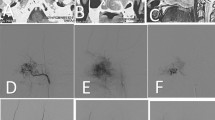Abstract
The objective of the study was to present our experience with definitive endonasal endoscopic management of patients with Radkowski stage IA&B and IIA Juvenile nasopharyngeal angiofibroma (JNAs) without preoperative angiographic embolization. This was a retrospective study performed at tertiary referral center. 18 males with JNAs stage IA&B and II A according to Radkowski classification were included in this study. Their ages ranged from 14 to 23 years with a mean of 16.7 years. All patients were presented by nasal obstruction with recurrent epistaxis in 15 patients. All the patients underwent computed tomography and magnetic resonance imaging to delineate the extent and location of the tumor. Neither angiography nor embolization was done for any patient preoperatively. An endonasal endoscopic technique was used for excision of the tumors in all patients. Complete removal of the tumor was achieved in 16 patients with no residual or recurrent tumor. Two patients had residual tumors: the recurrence in the lateral wall of the sphenoid sinus in the first patient and in the pterygopalatine fossa in the other patient. Follow-up ranged from 14 to 72 months with a mean of 37.4 months. The mean of intraoperative blood loss was 342.3 ± 92.7 ml. The endonasal endoscopic approach is a safe and effective technique for small- and intermediate-sized JNAs (stage IA&B and IIA) without preoperative angiographic embolization. Hypotensive anesthesia, meticulous dissection as well as diathermy of the sphenopalatine artery greatly decrease the blood loss.



Similar content being viewed by others
References
Bales C, Kotapka M, Loevner LA, Al-Rawi M, Weinstein G, Hurst R et al (2002) Craniofacial resection of advanced juvenile nasopharyngeal angiofibroma. Arch Otolaryngol Head Neck Surg 128:1071–1078
El-BanhawyOA Ragab A, El-Sharnoby MM (2004) Surgical resection of type III juvenile angiofibroma without preoperative embolization. Int J Pediatr Otorhinolaryngol 68:21–28
Lee JT, Chen P, Safa A, Juillard G, Calcaterra TC (2002) The role of radiation in the treatment of advanced juvenile angiofibroma. Laryngoscope. 112:1213–1220
Spector JG (1988) Management of juvenile angiofibromata. Laryngoscope. 98:1016–1026
Chen WL, Huang ZQ, Li JS, Chai Q, Zhang DM (2010) Percutaneous sclerotherapy of juvenile nasopharyngeal angiofibroma using fibrin glue combined with OK-432 and bleomycin. Int J Pediatr Otorhinolaryngol 74:422–425
Goepfert H, Cangir A, Lee YY (1985) Chemotherapy for aggressive juvenile nasopharyngeal angiofibroma. Arch Otolaryngol. 111:285–289
Labra A, Chavolla-Magana R, Lopez-Ugalde A, Alanis-Calderon J, Huerta-Delgado A (2004) Flutamide as a preoperative treatment in juvenile angiofibroma (JA) with intracranial invasion: report of 7 cases. Otolaryngol Head Neck Surg 130:466–469
EL Morsy SM, Khafagy YW (2011) Transnasal endoscopic management of angiofibroma extending to pterygopalatine and infratemporal fossae. J Laryngol Otol 125:701–705
Radkowski D, McGill T, Healy GB (1996) Angiofibroma: changes in staging and treatment. Arch Otolaryngol Head Neck Surg 122(2):122–129
Yiotakis I, Anna E, Dimitrios D et al (2008) Juvenile nasopharyngeal angiofibroma stages I and II: a comparative study of surgical approaches. Int J Ped Otorhinolaryngol 72:793–800
Kamel RH (1996) Transnasal endoscopic surgery in juvenile nasopharyngeal angiofibroma. J Laryngol Otol 110:962–968
Gallia G, Ramanathan M, Blitz AM, Reh DD (2010) Expanded endonasal endoscopic approach for resection of a juvenile nasopharyngeal angiofibroma with skull base involvement. J Clin Neurosci 17:1423–1427
Robinson S, Patel N, Wormald PJ (2005) Endoscopic management of benign tumors extending into the infratemporal fossa: a two surgeons transnasal approach. Laryngoscope 115:1818–1822
Weber RK, Werner JA, Hildenbrand T (2010) Endonasal endoscopic medial maxillectomy with preservation of the inferior turbinate. Am J Rhinol Allergy 24(6):132–135
Bie YZ, Sun JW, Sun JQ, Guo T (2012) Endoscopic transnasal prelacrimal recess-maxillary sinus approach for tumors in the pterygopalatine fossa. Zhonghua Er Bi Yan Hou Tou Jing Wai Ke Za Zhi 47(1):26–29
Elhammady MS, Johnson JN, Peterson EC, Aziz-Sultan MA (2011) Preoperative embolization of juvenile nasopharyngeal angiofibromas: transarterial versus direct tumoral puncture. World Neurosurg 76:328–334
Aziz-Sultan MA, Moftakhar R, Wolfe SQ, Elhammady MS, Herman B, Farhat H (2011) Endoscopically assisted intratumoral embolization of juvenile nasopharyngeal angiofibroma using Onyx. J Neurosurg Pediatr 7(6):600–603
Conflict of interest
None.
Author information
Authors and Affiliations
Corresponding author
Rights and permissions
About this article
Cite this article
El Sharkawy, A.A. Endonasal endoscopic management of juvenile nasopharyngeal angiofibroma without angiographic embolization. Eur Arch Otorhinolaryngol 270, 2051–2055 (2013). https://doi.org/10.1007/s00405-012-2315-x
Received:
Accepted:
Published:
Issue Date:
DOI: https://doi.org/10.1007/s00405-012-2315-x




